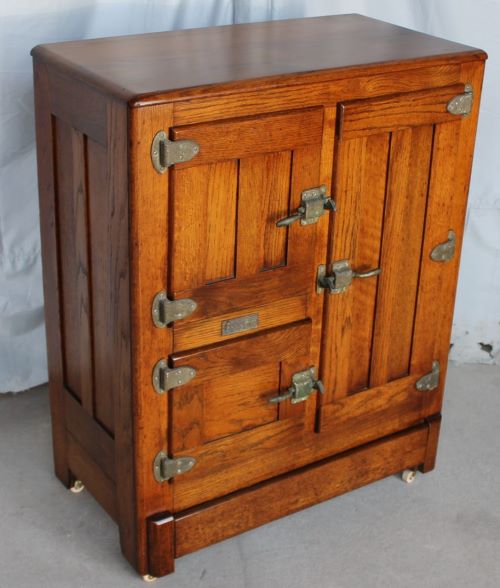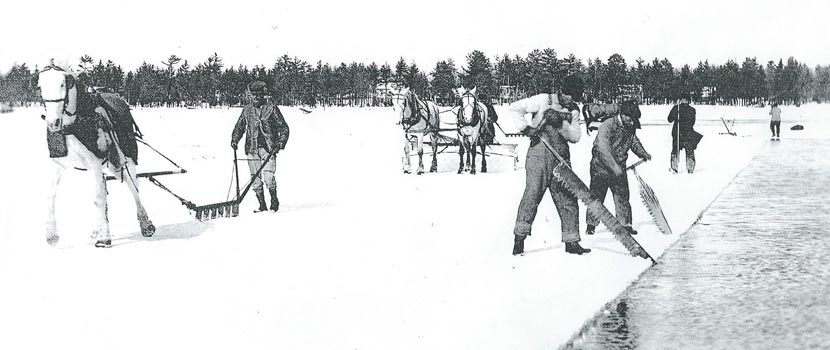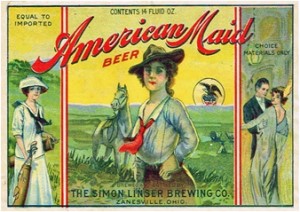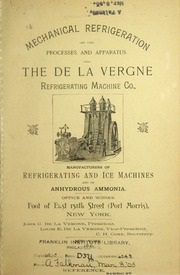The 'Stock' Exchange
Kaufmann & Strauss Co. 'Ice Box Lady'
Kaufmann & Strauss Co. 'Ice Box Lady'
Click the Picture
to Return to K&S Stock Catalog Page
to Return to K&S Stock Catalog Page
Date: Pre-pro
Size: 13.5" x 10.5"
Style: Pie
Scarcity: Common
Value: $$$ to $$$$
Condition & Brewer Dependent
Size: 13.5" x 10.5"
Style: Pie
Scarcity: Common
Value: $$$ to $$$$
Condition & Brewer Dependent
Confirmed Brewer used Stock Trays

Non-Beer Related & Non-Tray Uses

General
Meek/American Arts Works wasn’t the only tray manufacturer reflecting social and technological changes of the era. The woman (who by her uniform-style outfit is mostly likely meant to represent a domestic servant, again reflecting that upwardly mobile connotation so prevalent among advertisers of the day) is putting bottles of beer to chill into what we refer to nowadays as an icebox.
An 'icebox' (also called a 'cold closet') is a compact non-mechanical refrigerator which was a common early-twentieth-century kitchen appliance before the development of safely powered refrigeration devices. Before the development of electric refrigerators, iceboxes were referred to by the public as "refrigerators". Only after the invention of the modern day electric refrigerator did early non-electric refrigerators become known as iceboxes. The terms ice box and refrigerator were used interchangeably in advertising as long ago as 1848.
Meek/American Arts Works wasn’t the only tray manufacturer reflecting social and technological changes of the era. The woman (who by her uniform-style outfit is mostly likely meant to represent a domestic servant, again reflecting that upwardly mobile connotation so prevalent among advertisers of the day) is putting bottles of beer to chill into what we refer to nowadays as an icebox.
An 'icebox' (also called a 'cold closet') is a compact non-mechanical refrigerator which was a common early-twentieth-century kitchen appliance before the development of safely powered refrigeration devices. Before the development of electric refrigerators, iceboxes were referred to by the public as "refrigerators". Only after the invention of the modern day electric refrigerator did early non-electric refrigerators become known as iceboxes. The terms ice box and refrigerator were used interchangeably in advertising as long ago as 1848.
The more traditional icebox dates back to the days of ice harvesting, which had hit an industrial high that ran from the mid-19th century until the 1930s, when the refrigerator was introduced into the home. Most municipally consumed ice was harvested in winter from snow-packed areas or frozen lakes, stored in ice houses, and delivered domestically.
In 1827 the commercial ice cutter was invented, which increased the ease and efficiency of harvesting natural ice. This invention made ice cheaper and in turn helped the icebox become more common. Up until this point, iceboxes were used for personal means but not for mass manufacturing.
By the 1840s, various companies appeared including Sears, The Baldwin Refrigerator Company, and the Ranney Refrigerator Company started getting involved in the icebox manufacturing industry. D. Eddy & Son of Boston is considered to be the first company to produce iceboxes in mass quantities. During this time, many Americans desired big iceboxes. Companies such as the Boston Scientific Refrigerator Company introduced iceboxes which could hold up to 50 lbs. of ice.
In a 1907 survey of expenditures of New York City inhabitants, 81% of the families surveyed were found to possess "refrigerators" either in the form of ice stored in a tub or iceboxes.
The icebox was invented by an American farmer and cabinetmaker named Thomas Moore in 1802. Moore used the icebox to transport butter from his home to the Georgetown markets, which allowed him to sell firm, brick butter instead of soft, melted tubs like his fellow vendors at the time. His first design consisted of an oval cedar tub with a tin container fitted inside with ice between them, all wrapped in rabbit fur to insulate the device.
Later versions would include hollow walls that were lined with tin or zinc and packed with various insulating materials such as cork, sawdust, straw or seaweed. A large block of ice is held in a tray or compartment near the top of the box. Cold air circulates down and around storage compartments in the lower section. Some finer models have spigots for draining ice water from a catch pan or holding tank. In cheaper models, a drip pan is placed under the box and has to be emptied at least daily. The user has to replenish the melted ice, normally by obtaining new ice from an iceman. The dresser-like structure featured solid hardwood, mostly integrating either oak or walnut pieces.
The design of the icebox allowed perishable foods to be stored longer than before and without the need for lengthier preservation processes such as smoking, drying, or canning. Refrigerating perishables also had the added benefit of not altering the taste of what it is preserving. Iceboxes ranged in price from $15 to $50, depending on their sizes and features.
As the techniques for food preservation steadily improved, prices decreased and food became more readily available. As more households adopted the icebox, the overall quality and freshness of this food was also improved. Iceboxes meant that people were able to go to the market less and could more safely store leftovers. It also conveniently happened be to a reasonable way to cool down bottled beer, which was also becoming more readily available around this time, especially for those living in cities who didn’t have their own cellar.
In 1827 the commercial ice cutter was invented, which increased the ease and efficiency of harvesting natural ice. This invention made ice cheaper and in turn helped the icebox become more common. Up until this point, iceboxes were used for personal means but not for mass manufacturing.
By the 1840s, various companies appeared including Sears, The Baldwin Refrigerator Company, and the Ranney Refrigerator Company started getting involved in the icebox manufacturing industry. D. Eddy & Son of Boston is considered to be the first company to produce iceboxes in mass quantities. During this time, many Americans desired big iceboxes. Companies such as the Boston Scientific Refrigerator Company introduced iceboxes which could hold up to 50 lbs. of ice.
In a 1907 survey of expenditures of New York City inhabitants, 81% of the families surveyed were found to possess "refrigerators" either in the form of ice stored in a tub or iceboxes.
The icebox was invented by an American farmer and cabinetmaker named Thomas Moore in 1802. Moore used the icebox to transport butter from his home to the Georgetown markets, which allowed him to sell firm, brick butter instead of soft, melted tubs like his fellow vendors at the time. His first design consisted of an oval cedar tub with a tin container fitted inside with ice between them, all wrapped in rabbit fur to insulate the device.
Later versions would include hollow walls that were lined with tin or zinc and packed with various insulating materials such as cork, sawdust, straw or seaweed. A large block of ice is held in a tray or compartment near the top of the box. Cold air circulates down and around storage compartments in the lower section. Some finer models have spigots for draining ice water from a catch pan or holding tank. In cheaper models, a drip pan is placed under the box and has to be emptied at least daily. The user has to replenish the melted ice, normally by obtaining new ice from an iceman. The dresser-like structure featured solid hardwood, mostly integrating either oak or walnut pieces.
The design of the icebox allowed perishable foods to be stored longer than before and without the need for lengthier preservation processes such as smoking, drying, or canning. Refrigerating perishables also had the added benefit of not altering the taste of what it is preserving. Iceboxes ranged in price from $15 to $50, depending on their sizes and features.
As the techniques for food preservation steadily improved, prices decreased and food became more readily available. As more households adopted the icebox, the overall quality and freshness of this food was also improved. Iceboxes meant that people were able to go to the market less and could more safely store leftovers. It also conveniently happened be to a reasonable way to cool down bottled beer, which was also becoming more readily available around this time, especially for those living in cities who didn’t have their own cellar.


Ice Harvesting
Icebox

De La Vergne
Refrigerator Machine Co.
Refrigerator Machine Co.
Simon Linser Brewing Co.
'American Maid Beer'
'American Maid Beer'
All of this contributed to the improvement of the population's health by increasing the fresh food readily able to be consumed and the overall safety of that food. By the early 1930s, mechanical ice machines gradually began to rise over the ice harvesting industry thanks to its ability to produce clean, sanitary ice independently and year-round. Over time, as the mechanical ice machines became smaller, cheaper, and more efficient, they easily replaced the hassle of getting ice from a source. For example, the De La Vergne Refrigerating Machine Company of New York, New York could produce up to 220 tons of ice in a single day from a single machine.
With widespread electrification and safer refrigerants, mechanical refrigeration in the home became possible. With the development of the chlorofluorocarbons (along with the succeeding hydrochlorofluorocarbons and hydrofluorocarbons), that came to replace the use of toxic ammonia gas, the refrigerator replaced the icebox, though icebox is still sometimes used to refer to mechanical refrigerators.
The first fridge to become widely popular was made by General Electric in 1927, which customers could purchase for $520—over $7,000 in today’s money! Thanks to discounts made available by General Electric and other manufacturers, refrigerator sales grew steadily into the Great Depression when it was unthinkable to throw away leftovers. By 1935, the era of electric refrigeration began in earnest, and by 1944, 85 percent of American households featured a refrigerator in the kitchen.
We’ve only encountered examples from two different breweries, Peter Breidt City Brewery of Elizabeth, NJ and Simon Linser Brewing of Zanesville, OH; given the subject matter it’d be unexpected to find examples from non-brewers, or even stock samples. One difference between the two examples is the color of the beer bottles; Breidt’s are clear while Linser’s are brown. Obviously the associated labels are different too, reflecting each brand. We have found actual labels for Simon Linser Brewing that appear to match those depicted in the design. Our search for a Breidt label, including consultation with Bob Kay’s US Beer Labels, Volume II (which covers New Jersey), has not turned up anything resembling what appears on the tray. Perhaps our label collector friends can help us identify whether there is an actual Peter Breidt label like those depicted.
Size/Shape and Advertising Placement
All examples we’ve seen have been 10.5" x 13.5" small oblongs. K&S did not engage in multiple form factors for its stock designs to the extent Meek/American Art Works or H.D. Beach did. Examples from Breidt and Linser both use the inside of the icebox door for primary advertising of their brands featuring text in at least two colors (red and black for Breidt, black and teal for Linser). Both examples feature the same rim design with typical art nouveau flourishes and the exact same advertising text on the top and bottom rims—“Have it at home; when you want it!”-- quite probably reflecting brewers moves to disassociate their products from the saloon, hereby establish beer as a more “respectable” beverage.
Price
Of the two, we’ve encountered the Peter Breidt examples far more often; perhaps two out of every three examples. There may be a slightly higher value for Linser examples in comparable condition. Average examples go for low triple figures with better quality examples commanding higher prices with excellent examples reaching the low four figures.
With widespread electrification and safer refrigerants, mechanical refrigeration in the home became possible. With the development of the chlorofluorocarbons (along with the succeeding hydrochlorofluorocarbons and hydrofluorocarbons), that came to replace the use of toxic ammonia gas, the refrigerator replaced the icebox, though icebox is still sometimes used to refer to mechanical refrigerators.
The first fridge to become widely popular was made by General Electric in 1927, which customers could purchase for $520—over $7,000 in today’s money! Thanks to discounts made available by General Electric and other manufacturers, refrigerator sales grew steadily into the Great Depression when it was unthinkable to throw away leftovers. By 1935, the era of electric refrigeration began in earnest, and by 1944, 85 percent of American households featured a refrigerator in the kitchen.
We’ve only encountered examples from two different breweries, Peter Breidt City Brewery of Elizabeth, NJ and Simon Linser Brewing of Zanesville, OH; given the subject matter it’d be unexpected to find examples from non-brewers, or even stock samples. One difference between the two examples is the color of the beer bottles; Breidt’s are clear while Linser’s are brown. Obviously the associated labels are different too, reflecting each brand. We have found actual labels for Simon Linser Brewing that appear to match those depicted in the design. Our search for a Breidt label, including consultation with Bob Kay’s US Beer Labels, Volume II (which covers New Jersey), has not turned up anything resembling what appears on the tray. Perhaps our label collector friends can help us identify whether there is an actual Peter Breidt label like those depicted.
Size/Shape and Advertising Placement
All examples we’ve seen have been 10.5" x 13.5" small oblongs. K&S did not engage in multiple form factors for its stock designs to the extent Meek/American Art Works or H.D. Beach did. Examples from Breidt and Linser both use the inside of the icebox door for primary advertising of their brands featuring text in at least two colors (red and black for Breidt, black and teal for Linser). Both examples feature the same rim design with typical art nouveau flourishes and the exact same advertising text on the top and bottom rims—“Have it at home; when you want it!”-- quite probably reflecting brewers moves to disassociate their products from the saloon, hereby establish beer as a more “respectable” beverage.
Price
Of the two, we’ve encountered the Peter Breidt examples far more often; perhaps two out of every three examples. There may be a slightly higher value for Linser examples in comparable condition. Average examples go for low triple figures with better quality examples commanding higher prices with excellent examples reaching the low four figures.




